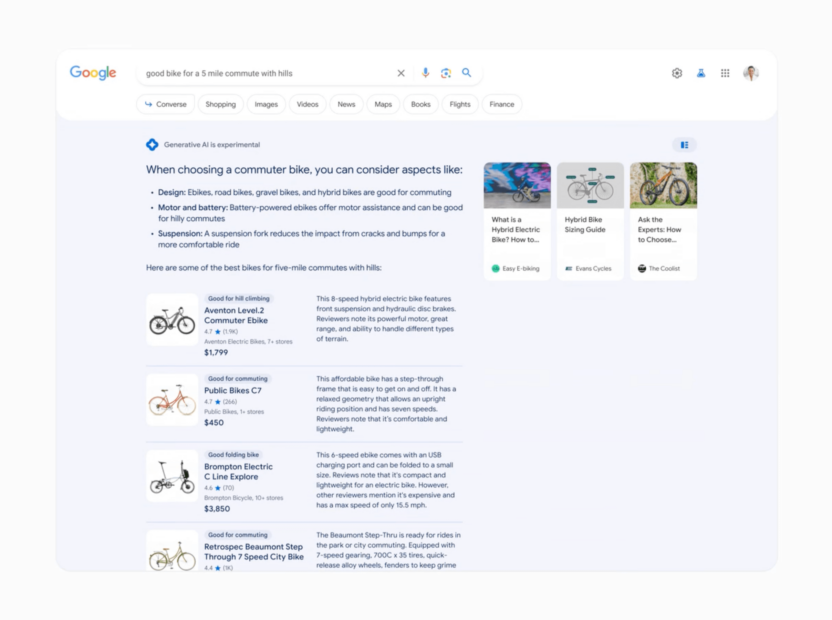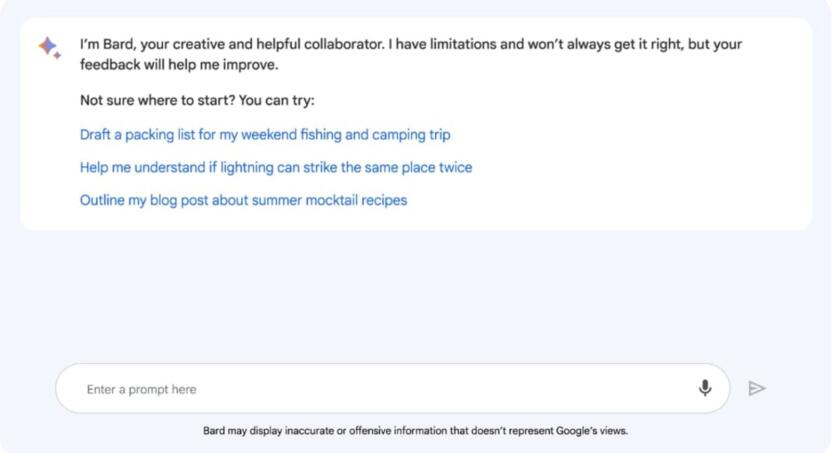Google I/O 2023 Updates For Marketers, Without All The Tech Jargon

Reading Time: 8 minutes
The Google IO 2023, similar to last year’s Google Developer Conference, was held at their HQ in Mountain View, California. AI has been at the forefront of this year’s theme. For mobile marketers, it’s important to prepare marketing strategies and plans according to these updates to stay ahead of competitors and get the maximum ROI.
Here’s a quick recap of the latest announcements and updates (you can check out how it’s different from the Google IO 2022 or click below to navigate through this year’s updates).
- Google Search
- Generative AI in Search
- Generative AI in Shopping
- Bard, Google’s Conversational AI Chatbot, Gets Smarter!
- Duet AI for Workspace – Get More Work Done In Lesser Time
- Android 14 Round-up
- Full-Screen Intent Notifications
- Reduced Reliance on Passwords on Android
- Privacy Sandbox
- Wrapping Up
Google Search
Google has created innovative ways to help consumers find valuable information for their search queries. Search now answers queries in ways that would transform how information is organized, making it much easier to sort through the search results and helping you find precisely what you’re looking for.
Generative AI in Search
With an emphasis on generative AI, Google has reimagined and innovated its search engine capabilities.
Search will soon reduce the noise and clutter from search results to help understand topics faster, get meaningful insights, and get things done easily and quickly.
Search results will now show you suggested next steps for your query and the ability to ask follow-up questions to your original search query. When you click on these, it takes you to a conversational mode where you can ask Google more questions to dig deeper into your search.

How can marketers leverage this?
Marketers can take an analytical approach to how customers and visitors land on their websites. Wondering how?
Let’s take an example for a travel and hospitality brand that wants to optimize its website for queries such as “Budget-friendly destinations in Europe for winter sports for women who want to go on a solo trip.” The key here is an analytical approach to showing economical flights, hotel accommodations, destinations, and cab bookings.
First, you would need to understand your target audience and segment them based on various attributes such as age, demographics, behavior, destinations they are interested in, previous browsing, and purchase history. You would then want to tailor your recommendations based on the insights you’ve gleaned from these factors.
What would this look like? This could suggest destinations popular for winter sports, such as Switzerland or even Sochi, where the 2014 Winter Olympics was held. Now you want to make sure these are safe for female travelers, and you accordingly suggest safe hotels or cabins in these destinations based on reviews from other customers while showing flights to these destinations that are economical to fly from their current location by using their location data. You can tailor your website to show similar destinations and other results based on these attributes.
MoEngage Pro Tip💡
|
Generative AI in Shopping
With generative AI in Search, the shopping experience takes a whole new approach, making it easier to make purchases for even the most complex purchase decisions.
With the new announcements, when searching for a product, you’ll see a snapshot of important factors to consider and will be shown products that conform to the criteria. Moreover, search results will also show product descriptions that comprise relevant and updated reviews, ratings, prices, and product images.
Let’s take an example of a product search for a bike needed for a 5-mile hill commute. The search results will display bike options with prices, ratings, reviews, and product descriptions, as shown below.

We love to learn about others’ experiences with a product or a service before making buying decisions. Tapping into this sentiment, Google wants to help its users dive deeper into the topic they want to learn more about.
For marketers, this would imply that it’s important to pay attention to the content on their websites to show relevant, updated, contextual, and concise product information to have Google send valuable traffic to your website.
MoEngage Pro Tip💡A/B test the copies of your product descriptions along with helpful and relevant content that your target audience is likely to consume and help them make an informed purchase decision. We’d recommend that you first understand your audience, what they like, what they’ve previously purchased or viewed, their past product and page interactions, and even their location, to offer helpful information about your products. A great way to do this is by letting a powerful AI like Sherpa do the heavy lifting for you for running multiple A/B tests at scale and optimizing your campaigns to deliver better results. |
Bard, Google’s Conversational AI Chatbot, Gets Smarter!
Google’s conversational AI chatbot, Bard, is ChatGPT’s alternative. It’s separate from Google Search. Bard is conversational and gives users human-like responses (including text and images) to the prompts it receives.
At Google IO 2023, Google revealed that it’s removing its waitlist and making it available in English in over 180 countries while launching support in Japanese and Korean as well. It’s expected to support forty languages in the near future. What’s more, Bard now has the ability to show images in its responses. Bard users can now generate images via Adobe’s Firefly and edit them using Express. You can choose from their array of templates, fonts, and stock images from the Express library.
How can marketers use Bard?
Marketers can use Bard to conduct market research and stay productive and creative. How?
Bard can help you generate content, translate languages, and give answers to your prompts and questions.
For example, when you search for Push Notification template copies, you will see links to various websites and blogs that cover this topic. But when you search the same on Bard, it can give you the actual copies for Push Notification templates. Bard simplifies the process of getting information and giving you the results you were actually looking for. This means no more scrolling through pages with little luck in getting what you were looking for.
Bard can even help you with writing marketing email newsletter copies to SMS marketing templates!

MoEngage Pro Tip💡While Bard can help you in your marketing efforts, personalization is important to stay ahead of the competition. Use a robust insights-led customer engagement platform like MoEngage to get insights into your target audience, segment them, know which channel works best for which segment, and give specific prompts to Bard to receive a relevant and specific response to make your campaigns more relevant, contextual, and personalized. Let’s say you want to create a Mother’s Day campaign to boost conversions for your E-commerce jewelry brand.You can use MoEngage to identify key segments of your target audience and the channels that have worked best for those various segments and craft your prompt into Bard. For instance, you can tell Bard to give you Push Notification copies for a Mother’s Day campaign in India for a jewelry brand. The target audience is women aged 25 – 35 who want to gift their mothers jewelry on Mother’s Day. This method will boost your North Star Metrics and help you craft useful marketing content. |
Duet AI for Workspace – Get More Work Done In Lesser Time
Google has embedded generative AI across all its Workspace apps with Duet AI for Google Workspace and has helped users write over a billion times. While Gmail already uses AI to help you draft email replies, more exciting updates will help marketers boost their marketing.
Slides
Generative AI, now deployed in Google Sheets, can help marketers easily and quickly create images from text descriptions. You can use this feature to add more visual elements to your presentations with reduced to no design dependencies or scour the internet for images!

Sheets
AI in Sheets can now help you automate data classification, helping you organize projects that can track and analyze data efficiently.
Docs
Looking for help in creating blog posts or email copies? Generative AI embedded into Google Docs has you covered. Simply enter what you want to write about and instantly get a draft in seconds!

With Smart Chips, variables, and templates, you can easily reference others who use Google, files, dates, calendar events, and more! Smart Chips are similar to hyperlinks but show more information when you hover over them. This is helpful in collaborating with colleagues and receiving feedback while providing shortcuts for any action added directly to your document.
Android 14 Round-up
With the announcement of Android 14 2nd beta version at Google I/O this year, there are some exciting updates about this popular next-gen OS. Smartphones are the first contact point with customers for mobile marketers. Content and visual elements are key to grabbing eyeballs on mobile apps.
The latest updates to the Material You design offers an array of customization options. Users can personalize their device’s appearance with custom wallpapers, color themes, device layouts, and some cool design elements. For marketers, this could affect how their target audience sees websites and apps. How? You might want to prep your website and app in terms of design and branding.
For instance, when users start typing to search for something on their devices, their previous search suggestions can show up below the search bar.
Full-Screen Intent Notifications
FSI notifications are meant for high-priority notifications that require your customer’s immediate attention. Such instances include an incoming phone call or user-configured alarm clock settings.
Android 11 allowed apps to send Full Screen Intent (FSI) Notifications while the phone was locked. Access to full-screen notifications is also changing with the new Android 14. Apps would now need to request Full-Screen Intent (FSI) Notifications from their customers when the phones are locked.
Reduced Reliance on Passwords on Android
Android 14 helps users move to a passwordless world with Passkeys. Passkeys is a new authentication method to replace passwords. Passkeys use familiar patterns such as screen unlock or a biometric check which can help your customers sign into apps faster. This can help boost your app’s sign-in rates (and a potential high app interaction and engagement). This also means your customers can sign into your app across Android devices, such as mobile phones, browsers, and tablets.
Privacy Sandbox
The Privacy Sandbox can work in sync across web and mobile platforms to provide you with valuable insights and conduct more accurate attribution. Cross-web and app attribution is currently available on Chrome and Android platforms. This means that conversions on your app are attributed to ads shown on the web and vice versa.
Wrapping Up
The announcements and updates during Google I/O 2023 have created a buzz with its key theme of integrating AI into how we search, shop, work, and play. You can read all about the event and learn in greater detail here.
Generative AI, Search, shopping, marketing, and Android 14 have AI at its core, along with ways to boost creativity and productivity in an effective and effective way. And this is only the beginning.
We at MoEngage are excited to help you leverage these updates and changes for your brand to get the maximum marketing ROI (yes, even with budget cuts!).
Want to share something about these new features with us? You can tweet it to us.







